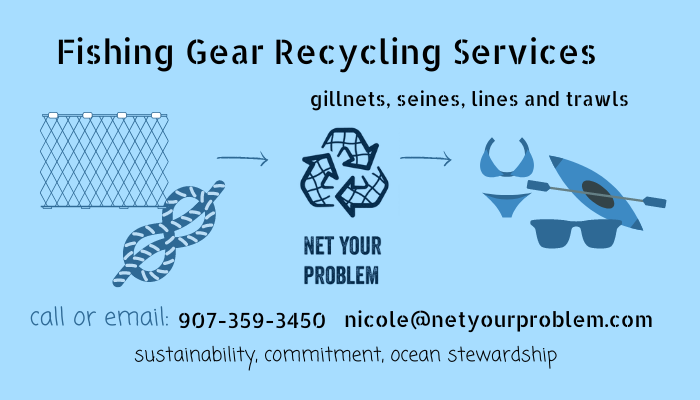Seawatch by Cristy Fry
February 11, 2021
The North Pacific Fisheries Management Council is struggling with how to deal with three strong year classes of sablefish that are being caught in the directed fishery that are too small to be of much value but must be retained under IFQ fishing regulations.
Part of the problem is those strong year classes are currently made up of juvenile fish weighing about three pounds or less, and taking them out of the biomass before they can grow to marketable size and add to the spawning biomass is detrimental.
This week the Council considered action that will allow fishermen to release small sablefish back into the ocean. Like halibut, sablefish have no air bladders and can survive the trip to the surface.
However, not all fish do survive, which creates a problem for trying to determine the directed mortality rate, which is how many of them would die in the directed fishery.
The end result was a decision to revisit the issue in April.
Former Council member and sablefish fisherman Buck Laukitis said that there are a couple of issues.
“Most of the longline and pot boats see this as a big thing that they're seeing on the grounds. 'We're seeing lots of little fish, there's no big ones, we don't like the idea of retaining these when we need them to grow up and spawn.' In the fishermen's minds it's a conservation issue.”
He said the other problem is the trawlers who seem have outsized power on the Council.
“The IFQ program was supposed to be no high grading, no discards. In that sense you could call this high grading, you could call this discards. You're not really hearing people upset about that, unless you're a trawler, and then they're using that.
“Some of the dynamic is the trawlers are 400-500% over their (bycatch) quota, and everything they discard is dead; we're talking about tote after cannery tote of dead black cod being dumped at sea or ground up at the plant to make fish meal out of them to feed our fish farmer competitors.”
Laukitis said that with longliners, hook size is selective, the bigger the hook the bigger the fish usually caught, and fish of all sizes experience some mortality. With pots, everything tends to come up alive, and likely have a much higher survival rate.
Even then, longline tagging studies have shown that somewhere between 80 and 90% of fish released survive, something Linda Behnkin, director of the Alaska Longline Fishermen's Association, told KMXT Public Radio in Kodiak was somewhere around 25% of 1% of the biomass.
“There's a lot of concerns raised in the analysis about the impact of this action on the sablefish stock and the catch accounting system, and I think those really need to be put into context, as to how many fish we're talking about relative to the sablefish biomass,” she said.
She added that not every fisherman will choose to release fish under 3 pounds, and not every fisherman who does choose to release them will release them every time. There will be times when fishermen will choose to keep a dead small sablefish and release those in good condition, times due to operational constraints that they will decide to keep every fish, and times when they will have the time to release the small fish carefully.
She urged the Council to study it further.
“If they go get some data, I think they'll find that it's not the big issue we're hearing that it might be, and it will provide important flexibility to take care of these juvenile fish where we have this phenomenal year class coming into the stocks.”
Laukitis said that those discards will have to be accounted for, and it is going to come out of people's quota, it is just a question of how they account for it.
“It's going to come out of people's quota,” he said, not from individual fishermen who choose to discard but from the overall directed fishery quota, but in the long run will lead to larger fish of higher value and more spawners in the biomass to create more sablefish.
He added that some of the processors will not even buy the smaller fish when they are delivered, but they still come off that person's IFQs.
“Some of these things are being lost on the decision makers,” he said.
He said that the whole thing is typical for the National Marine Fisheries Service as an agency.
“They just throw up their hands and say 'oh, it's going to throw off our stock assessment, it's going to throw off our observer program, we won't know how to count it,' it's the classic reality meets the agency kind of thing.”
He added that it is the job of the Council to force NMFS to take action, even if the agency is reluctant to do so.
Laukitis said that the Council's deference to the trawlers was evident in previous actions.
“The trawl fleet was able to get the Council to convince the (Secretary of Commerce) to agree in one meeting that all (sablefish) are all one stock, there is no problem going 500 percent over their bycatch limit for a couple of years in the Bering Sea. They did that in an afternoon, but it has taken 3-4 years to get this small sablefish discard thing going.”
Observer coverage also plays a role, with Laukitis estimating that only 11% of sablefish boats having observers, which puts a pretty big dent in the available observer data for the directed fishery.
This problem is not new, it first came up when a large year class came up in 2014, but could be gaining urgency, according to Council staff member Jim Armstrong.
He told KMXT, “No one had every seen anything like it, because the closest they'd ever come close to the size of the 2014 year class was in the late 1970's.”
Managers thought maybe it would go away, and then came 2016-2017 year classes.
“Are we in a regime of high sablefish productivity? I'm not sure anyone is ready to say that. I think that the way people are thinking about it is maybe wanting to have something in place that's more of a long-term solution.”
This article also appears in the Homer News. Cristy Fry can be reached at [email protected].






